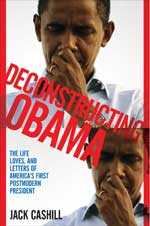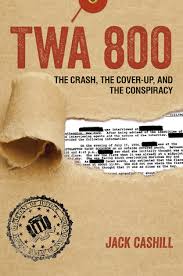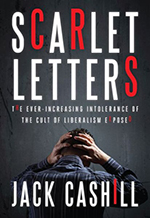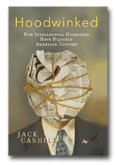New Bio Scrambles to Protect Obama's Literary Rep
_____
Order Jack Cashill's latest book, TWA 800: The Crash, the Cover-Up, and the Conspiracy
______
Order Jack Cashill's book,
Scarlet Letters
___
Get your copy of Jack Cashill's book, "You Lie!"

___
Get your copy of Deconstructing Obama

___
Jack Cashill's book:
Hoodwinked: How Intellectual Hucksters have Hijacked American Culture
© Jack Cashill
AmericanThinker.com- May 15, 2017
"I've written two books," candidate Barack Obama told a crowd of teachers in Virginia in July of 2008. The crowd applauded. "I actually wrote them myself."
In his massive new biography about Obama’s pre-presidential years, Rising Star: The Making of Barack Obama, Pulitzer Prize-winner David Garrow chose to cut this literary baby in half. Yes, Obama had help with his 1995 masterpiece, Dreams from My Father, a lot of help, but it sure as hell did not come from local editorial guru, Bill Ayers. In the book Garrow does not even raise the Ayers question. It is seemingly beneath his dignity. The help allegedly came from a law school buddy named Rob Fisher.
As to Obama’s presumed genius, Garrow never quite endorses it, but he does not challenge it either. He makes no comment, for instance, on the literary quality of Obama’s first published essay, “Breaking the War Mentality,” written during Obama’s senior year at Columbia. He should have.
The essay is clunky, pedestrian, and wonkish, a C- paper in freshman comp, maybe less given that there are five sentences in which the noun and verb do not agree. As a curiosity both Garrow and earlier biographer David Marannis quote the same one of those five sentences, and each fixes it to make the grammatical problem either go away or look less obvious.
“In retrospect,” Garrow quotes Obama as saying, “I can’t imagine anything harder than writing a book.” For a writer, writing a book is no big deal, but Obama was not a writer. He lacked both the talent and the discipline. He missed his first contracted deadline by a mile and even then the half-book he turned in to the publisher was, according to Garrow’s source, “bloated in some parts and dull in others.” The publisher terminated the contract
Wanting to get away to write, Obama left his new bride behind and headed off to Bali. He expected to take two months, but Garrow’s source tells him Obama was done within “five or six weeks.” As the source confirms, Obama wrote longhand on yellow notepads.
Back in Chicago in late winter 1993, Obama “faced a trio of responsibilities.” These included his law job, his new teaching gig at the University of Chicago, and the book, not to mention house shopping with Michelle. Later that year, the ever-busy Obamas would move, and Barack joined two new boards. Still, “by late spring” 1993, he had done enough to attract a new publisher.
With the help of Fisher, who lived in Maryland, Obama had “radically restructured” the book to make it more personal. In December 1993, Obama asked Fisher, “who had been doing so much yeoman’s work on Barack’s book manuscript,” to interview for a job at his law firm. Fisher took the interview, but he chose to stay in Maryland.
“In late spring 1994,” according to Garrow, Obama took six weeks off from his law firm job to finish the book. He needed to add the third section, the one on Africa. Garrow claims Obama worked largely from letters he sent in 1988 while in Kenya and retrieved from his girlfriend at the time, Sheila Jager.
Fellow Pulitzer Prize-winner David Maraniss told a different story in his 2012 bio. Maraniss paraphrased Crown editor Henry Ferris as saying that “Obama traveled to Kenya a second time for further research before turning in the last part of the book.” Marannis interviewed Obama on this subject, and Obama confirmed he went to Kenya once more for “fact-checking” and to do “more background on things like Kenyan history.” There is no record of this mystery trip, which would have taken place in spring 1994.
A third possibility, one neither Garrow nor Marannis raised, is that Obama lied to Ferris about making a return trip to Kenya, possibly to show how serious he was about finishing the book and getting his facts straight. Instead of going to Africa, Obama may have contented himself with going to the local library and pillaging the memoirs oflongtime Kenya resident Kuki Gallmann.
This is the theory proposed by tireless researcher Shawn Glasco. He was intrigued by the many words and phrases in Dreams that also appeared in Gallmann’s book, African Nights, which was published in 1994.
On the fashion front, both books have young women "wrapped" in their kangas and "dressed" in "rags." The women in both books wear shukas, head shawls, head scarves, goatskins, and balance baskets on heads graced with "laughing smiles."
On the animal front, men in both books spearfish in "ink-black" waters and hunt by torchlight. Elephants are seen "fanning" themselves, birds "trill," insects "buzz," weaver birds "nest," and monkeys "mesmerize." The books share a veritable Noah's ark of additional fauna: crickets, crocodiles, starlings, dragonflies, cattle, lions, sand crabs, vultures, hyenas, "herds of gazelle," and leopards that can hold small animals "in their jaws."
On the flora front, the shared references are just as compelling: roadside palms, yellow grass, red bougainvillaea, pink bougainvillaea, fig trees, shady mango trees, thornbrush, banana leaves, Baobab trees, liana vines, tomatoes. The landscape, occasionally "barren," is rich in "undulating hills" whose "grazing lands" are dotted with the occasional "watering hole." The "mud and dung" houses feature "thatched roofs" "verandas," and "vegetable gardens."
People seem to be carrying "straw mats" everywhere. The stars "glint" and people "waltz" underneath them. Eyes "glimmer" in the light of "campfires." Children sing in "high-pitched" rhythms, and girls endure "barbaric" circumcisions. Obama, like Gallmannn, travels to the Great Rift Valley and stands at its edge. Both visit the small trading town of Narok.
Given the timeline, the library seems a better bet than Kenya. According to Garrow, Obama flew to New York to hand the completed book off to Ferris no later than early June 1994. In other words, he completed the last third of the 450-page book some time between “late spring” 1994 and, well, late spring 1994.
Whenever Obama finished the book, Fisher allegedly played a major role. “I was deeply involved with helping him sort of shape it, the “normally self-effacing” Fisher admits. He also admits to having “had a big influence” on the final product. Remember, the book was written before e-mail.
Fisher is one of Garrow’s two big finds, the other being Sheila Jaeger. Seven years older than Obama and an established academic economist before starting law school, Fisher and Obama became good friends at Harvard. There, they co-authored a manuscript that, perhaps prophetically, was never finished.
One completed chapter dealt with the always sexy topic of plant closings. “The quest is to develop guidelines,” they wrote, “on how politically progressive movements can use the market mechanism to promote social goals.” They were particularly keen on “worker ownership and control.”
The second, more controversial chapter, was titled “Race and Rights Rhetoric.” Here, the authors describe America as “an admittedly racist culture” without acknowledging who has done the admitting.
Garrow quotes the unfinished manuscript extensively. Its style is wonkish and ungainly throughout. Sentences like the following suggest that one author wrote as awkwardly as the other: “While Yuppies can afford the expensive frivolities provided by The Sharper Image, others receive insufficient nutrition to allow their minds to develop properly.”
Oona King in her London Times review described Dreams as “a beautifully written personal memoir.” Noted British author Jonathan Raban claimed, "Every sentence has its own graceful cadence.” Obama’s gracefulness was limited to Dreams. What Garrow shows us of Fisher is equally flat and prosaic.
It seems highly unlikely that Obama’s economist muse lent the book its consciously Homeric structure. In December 2008, I published a piece in American Thinker in which I argued that in Dreams Obama "assumes the role of both Telemachus and Odysseus, the son seeking the father, and the father seeking home."
Three weeks later in the New York Times, the paper’s Pulitzer Prize-winning literary critic, Michiko Kakutani, described Dreams almost exactly as I had: "a quest in which [Obama] cast himself as both a Telemachus in search of his father and an Odysseus in search of a home." I seriously doubt if Ms. Kakutani purloined my thesis, especially given her conclusion that Dreams was "the most evocative, lyrical and candid autobiography written by a future president." She apparently inferred the Homeric structure in reading the text, as did I.
Early in his 2001 memoir, Fugitive Days, Ayers tips his Homeric hand. “Memory sails out upon a murky sea—wine-dark, opaque, unfathomable,” he writes with a knowing wink. “Wine-dark” is quintessential Homer. Best-selling author Thomas Cahill named his book on ancient Greece, Sailing the Wine-Dark Sea. It did not surprise me to learn that Cahill had attended my New York City high school, but then again so had Weather Underground alum, Brian Flanagan, who had taken the same Greek courses I did a year ahead of me. Ayers and pals may have been lunatics—Flanagan seems the sanest of the bunch--but they were literate ones.
Dreams and Fugitive Days, like the Odyssey, begin in media res, a literary technique in which the narrative starts in mid-story and not from the literal beginning. Odysseus’s son, Telemachus, is 20 when the Odyssey begins. Obama has just turned 21. Each saga begins with the young protagonist receiving an unexpected call that inspires him to seek out his missing father, Telemachus’s from Athena, Obama’s courtesy of Ma Bell.
The opening scene of Dreams unfolds in 1982, Obama’s senior year at Columbia, in and around a small New York City apartment with “slanting floors.” As the scene unfolds, Obama is making breakfast “with coffee on the stove and two eggs in the skillet.” In Fugitive Days, Ayers lives in apartments with “sloping floors” and talks about cooking almost as lovingly as he does bombing. He too uses the southern regionalism “skillet.”
At the climax of Dreams’ opening sequence, Obama receives the critical phone call. It comes from his Aunt Jane in Nairobi. “Listen, Barry, your father is dead,” she tells him. Obama has a hard time understanding. “Can you hear me?” she repeats. “I say, your father is dead.” The line is cut, and the conversation ends abruptly.
Apparently, Ayers so liked the dramatic structure of the Dreams’ opening sequence that he repeated it in Fugitive Days, which also opens in media res with a dramatic phone call. The call comes from future wife Bernardine Dohrn. Ayers learns that Diana Oughton had been killed in a Greenwich Village bomb blast. “Diana is dead,” says Dohrn. Ayers has a hard time understanding. “Diana is dead,” she “repeats slowly.” Ayers drops the line, and the conversation ends abruptly.
The Obama one meets in Dreams, a book Garrow describes as “historical fiction,” is filled with a rage that the people Garrow interviewed never saw in the real Obama. It seems highly unlikely that Obama’s economist muse lent the book its voice on black rage.
Ayers, however, was the co-creator of the “Days of Rage.” Like Obama, he began his career as a self-described “community organizer.” In Chicago, Ayers also found a strategic ally in Jeremiah Wright, a man he called a “distinguished theologian and major intellectual,” meaning that Wright too spelled “Amerikkka” with three Ks. In short, Ayers, unlike Fisher, was fully capable of crawling inside Obama’s head and relating in superior prose what Obama calls, only half-ironically, a “rage at the white world [that] needed no object.”
In Fugitive Days, “rage” rules. Ayers tells of how his “rage got started” and how it evolved into an “uncontrollable rage—fierce frenzy of fire and lava.” In fact, both Ayers and Obama speak of “rage” the way that Eskimos do of snow—in so many varieties, so often, that they feel the need to qualify it, as Obama does when he speaks of “impressive rage,” “suppressed rage” or “coil of rage.”
I know. These are just coincidences, as are the following coincidental word choices by Obama and former merchant seaman Ayers: fog, mist, ships, sinking ships, seas, sails, boats, oceans, calms, captains, charts, first mates, floods, shores, storms, streams, wind, waves, waters, anchors, barges, horizons, harbor, bays, ports, panoramas, moorings, tides, currents, voyages, narrower courses, uncertain courses, and things howling, wobbling, fluttering, sinking, leaking, cascading, swimming, knotted, ragged, tangled, boundless, uncharted, turbulent, and murky.
I could write a book about this. Come to think of it, I have. It’s called Deconstructing Obama, published by Simon & Schuster, the company that terminated Obama’s contract. Garrow fully ignores my book. He makes no mention of me in the text of his book, nor of Christopher Andersen.
In his 2009 book, Barack and Michele: Portrait of an American Marriage, Andersen relates how Obama found himself deeply in debt and “hopelessly blocked.” At “Michelle’s urging,” Obama “sought advice from his friend and Hyde Park neighbor Bill Ayers.” Noting that Obama had already taped interviews with many of his relatives, both African and American, Andersen elaborated, “These oral histories, along with his partial manuscript and a trunkload of notes were given to Ayers.” Andersen’s six-page account makes much more sense, logically and chronologically, than Garrow’s, but that too gets shoved down the memory hole.
I don’t doubt that Fisher played a role. Obama sent his manuscripts around pretty freely. I have seen the copy he sent to half-brother, Malik, asking for advice.
That said, to ignore Ayers’s role is pure malpractice. Ayers was not in Maryland. He was around the corner. He regularly helped aspiring leftist writers with their work, including Rashid Khalidi, who credited him generously. An aspiring politician, Obama knew better than to do that.
I have been told that when asked about Ayers on the air, Garrow dismisses the possibility that he was Obama’s muse. Radio hosts, if Garrow wants on your show, please ask if he will take a call from me.

Jack Cashill’s newest book, TWA 800: The Crash, the Cover up, the Conspiracy can now be ordered at Amazon.



